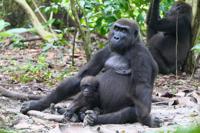(Photo by Tima Miroshnichenko via Pexels)
By Stephen Beech
Women live longer than men – except when males don’t play the field, suggests a new study.
Females tend to have greater longevity among species with strong competition for mates – as is the case with most mammals, say scientists.
But among birds – where males tend to stick to one breeding partner – males live around 5% longer than females.
Using records from more than 1,100 bird and mammal species in zoos worldwide, researchers found a “striking” lifespan contrast.
In most species of mammal (72%), females lived longer, on average by 12%, while in most bird species (68%), males lived longer, overall by an average of 5%.
Researchers say sex differences are more pronounced in wild populations than in zoos, suggesting that both genetic and environmental factors contribute to the discrepancy in life expectancy.
Around the world, women on average live longer than men.
Male and female olive baboons in the Bwindi Impenetrable Forest in Africa. (Martha Robbins via SWNS)
The striking pattern holds true across nearly all countries and historical time periods.
Although the gap between the sexes has narrowed in some countries due to medical advances and improved living conditions, the new research provides clues as to why that difference is unlikely to disappear anytime soon.
Scientists say the causes are deeply rooted in evolutionary history and can be observed in many species.
An international team, led by scientists from the Max Planck Institute for Evolutionary Anthropology (MPI-EVA), Germany, conducted the most comprehensive analysis of sex differences in lifespan across mammals and birds to date.
Their findings, published in the journal Science Advances, provide new insight into why males and females age differently.
One genetic explanation – known as “the heterogametic sex hypothesis” – points to differences in sex chromosomes.
In mammals, females have two X chromosomes, while males have only one X and one Y, making them the heterogametic sex.
(Photo by Mikhail Nilov via Pexels)
Some previous research suggests that having two X chromosomes may protect females from harmful mutations, offering a survival advantage.
But, in birds, the system is reversed: females are the heterogametic sex.
Study lead author Dr. Johanna Stärk, of the MPI-EVA, said: “Some species showed the opposite of the expected pattern.
“For example, in many birds of prey, females are both larger and longer-lived than males.
“So sex chromosomes can only be part of the story.”
She said that, as well as genetics, reproductive strategies also play a role.
Through sexual selection, males in particular develop conspicuous characteristics such as colourful plumage, weapons, or large body size, which increase reproductive success but can shorten lifespan.
The new study supports that assumption: in polygamous mammals with strong competition, males generally die earlier.
Western lowland gorillas in Loango National Park. (Martha Robbins via SWNS)
Overall, the differences were smallest in monogamous species, while polygamy and pronounced size differences were associated with a more pronounced longevity among females.
The researchers also found evidence that the sex that invests more in raising offspring – which is usually the females among mammals – tends to live longer.
Dr. Stärk said: “In long-lived species such as primates, this is likely to be a selective advantage: females survive until their offspring are independent or sexually mature.”
She says longevity gaps were often smaller in zoos but rarely disappeared – mirroring the human case, where advances in medicine and living conditions have narrowed but not eliminated the lifespan gap.
Dr. Stärk added: “The findings suggest that sex differences in lifespan are deeply rooted in evolutionary processes – shaped by sexual selection and parental investment and that genetic differences in the sex determination system may also play a role.
“Environmental factors influence the extent of the differences, but cannot eliminate them.
“The differences between the sexes are therefore not only a product of the environment, but part of our evolutionary history – and will most likely continue to exist in the future.”






